A micro controller is an integrated circuit or a chip with a processor and other support devices like program memory, data memory, I/O ports, serial communication interface etc integrated together. Unlike a microprocessor (ex: Intel 8085), a microcontroller does not require any external interfacing of support devices. Intel 8051 is the most popular microcontroller ever produced in the world market. Now lets talk about 8051 microcontroller in detail.
Before going further, it will be interesting for you to understand the difference between a Microprocessor and Microcontroller. We have a detailed article which describes the basic difference between both.
Microprocessor vs Microcontroller
Here is a Quick Access to various sections of this article:-
Pin Diagram :- Internal Architecture :- Program Memory Organization :- Data Memory Organization :-8051 System Clock :- 8051 Reset Circuit
Introduction
Intel first produced a microcontroller in 1976 under the name MCS-48, which was an 8 bit microcontroller. Later in 1980 they released a further improved version (which is also 8 bit), under the name MCS-51. The most popular microcontroller 8051 belongs to the MCS-51 family of microcontrollers by Intel. Following the success of 8051, many other semiconductor manufacturers released microcontrollers under their own brand name but using the MCS-51 core. Global companies and giants in semiconductor industry like Microchip, Zilog, Atmel, Philips, Siemens released products under their brand name. The specialty was that all these devices could be programmed using the same MCS-51 instruction sets. They basically differed in support device configurations like improved memory, presence of an ADC or DAC etc. Intel then released its first 16 bit microcontroller in 1982, under name MCS-96
Note:- Read the Story and History about Intel – the making of first Micro processor and more!
8051 Microcontroller Packaging
There is no need of explaining what each package means, you already know it. So I will skim through mainly used packaging for 8051. See, availability of various packages change from device to device. The most commonly used is Dual Inline Package (40 pins) – known popularly as DIP. 8051 is also available in QFP (Quad Flat Package), TQFP (Thin Quad Flat Package), PQFP (Plastic Quad Flat Package) etc. For explaining the pin diagram, we have used a 40 pin DIP IC as model.
8051 Microcontroller Architecture
Its possible to explain microcontroller architecture to a great detail, but we are limiting scope of this article to internal architecture, pin configuration, program memory and data memory organization. The basic architecture remains same for the MCS-51 family. In general all microcontrollers in MCS- 51 family are represented by XX51, where XX can take values like 80, 89 etc.
Schematic and Features
The general schematic diagram of 8051 microcontroller is shown above. We can see 3 system inputs, 3 control signals and 4 ports (for external interfacing). A Vcc power supply and ground is also shown. Now lets explain and go through each in detail. System inputs are necessary to make the micro controller functional. So the first and most important of this is power, marked as Vcc with a GND (ground potential). Without proper power supply, no electronic system would work. XTAL 1 and XTAL 2 are for the system clock inputs from crystal clock circuit. RESET input is required to initialize microcontroller to default/desired values and to make a new start.
There are 3 control signals, EA,PSEN and ALE. These signals known as External Access (EA), Program Store Enable (PSEN), and Address Latch Enable (ALE) are used for external memory interfacing.
Take a look at the schematic diagram below (a functional microcontroller)
As mentioned above, control signals are used for external memory interfacing. If there is no requirement of external memory interfacing then, EA pin is pulled high (connected to Vcc) and two others PSEN and ALE are left alone. You can also see a 0.1 micro farad decoupling capacitor connected to Vcc (to avoid HF oscillations at input).
There are four ports numbered 0,1,2,3 and called as Port 0, Port 1, Port 2 and Port 3 which are used for external interfacing of devices like DAC, ADC, 7 segment display, LED etc. Each port has 8 I/O lines and they all are bit programmable.
8051 Pin Diagram & Description
For describing pin diagram and pin configuration of 8051, we are taking into consideration a 40 pin DIP (Dual inline package). Now lets go through pin configuration in detail.
Pin-40 : Named as Vcc is the main power source. Usually its +5V DC.
You may note some pins are designated with two signals (shown in brackets).
Pins 32-39: Known as Port 0 (P0.0 to P0.7) – In addition to serving as I/O port, lower order address and data bus signals are multiplexed with this port (to serve the purpose of external memory interfacing). This is a bi directional I/O port (the only one in 8051) and external pull up resistors are required to function this port as I/O.
Pin-31:- EA/ External Access input is used to enable or disallow external memory interfacing. If there is no external memory requirement, this pin is pulled high by connecting it to Vcc.
Pin-30:- ALE aka Address Latch Enable is used to demultiplex the address-data signal of port 0 (for external memory interfacing.) 2 ALE pulses are available for each machine cycle.
Pin- 29:- PSEN or Program Store Enable is used to read signal from external program memory.
Pins- 21-28:- Known as Port 2 (P 2.0 to P 2.7) – in addition to serving as I/O port, higher order address bus signals are multiplexed with this quasi bi directional port.
Pin 20:- Named as Vss – it represents ground (0 V) connection.
Pins 18 and 19:- Used for interfacing an external crystal to provide system clock.
Pins 10 – 17:- Known as Port 3. This port also serves some other functions like interrupts, timer input, control signals for external memory interfacing RD and WR , serial communication signals RxD and TxD etc. This is a quasi bi directional port with internal pull up.
Pin 9:- As explained before RESET pin is used to set the 8051 microcontroller to its initial values, while the microcontroller is working or at the initial start of application. The RESET pin must be set high for 2 machine cycles.
Pins 1 – 8:- Known as Port 1. Unlike other ports, this port does not serve any other functions. Port 1 is an internally pulled up, quasi bi directional I/O port.
8051 Internal Architecture
There is no need of any detailed explanation to understand internal architecture of 8051 micro controller. Just look at the diagram above and you observer it carefully. The system bus connects all the support devices with the central processing unit. 8051 system bus composes of an 8 bit data bus and a 16 bit address bus and bus control signals. From the figure you can understand that all other devices like program memory, ports, data memory, serial interface, interrupt control, timers, and the central processing unit are all interfaced together through the system bus. RxD and TxD (serial port input and output) are interfaced with port 3.
8051 Memory Organization
Before going deep into the memory architecture of 8051, lets talk a little bit about two variations available for the same. They are Princeton architecture and Harvard architecture. Princeton architecture treats address memory and data memory as a single unit (does not distinguish between two) where as Harvard architecture treats program memory and data memory as separate entities. Thus Harvard architecture demands address, data and control bus for accessing them separately where as Princeton architecture does not demand any such separate bus.
Example:- 8051 micro controller is based on Harvard architecture and 8085 micro processor is based on Princeton architecture.
Thus 8051 has two memories :- Program memory and Data memory
Program memory organization
Now lets dive into the program memory organization 0f 8051. It has an internal program of 4K size and if needed an external memory can be added (by interfacing ) of size 60K maximum. So in total 64K size memory is available for 8051 micro controller. By default, the External Access (EA) pin should be connected Vcc so that instructions are fetched from internal memory initially. When the limit of internal memory (4K) is crossed, control will automatically move to external memory to fetch remaining instructions. If the programmer wants to fetch instruction from external memory only (bypassing the internal memory), then he must connect External Access (EA) pin to ground (GND).
You may already know that 8051 has a special feature of locking the program memory (internal) and hence protecting against software piracy. This feature is enable by program lock bits. Once these bits are programmed, contents of internal memory can not be accessed using an external circuitry. How ever locking the software is not possible if external memory is also used to store the software code. Only internal memory can be locked and protected. Once locked, these bits can be unlocked only by a memory-erase operation, which in turn will erase the programs in internal memory too.
8051 is capable of pipelining. Pipelining makes a processor capable of fetching the next instruction while executing previous instruction. Its some thing like multi tasking, doing more than one operation at a time. 8051 is capable of fetching first byte of the next instruction while executing the previous instruction.
Data memory organization
In the MCS-51 family, 8051 has 128 bytes of internal data memory and it allows interfacing external data memory of maximum size up to 64K. So the total size of data memory in 8051 can be upto 64K (external) + 128 bytes (internal). Observe the diagram carefully to get more understanding. So there are 3 separations/divisions of the data memory:- 1) Register banks 2) Bit addressable area 3) Scratch pad area.
Register banks form the lowest 32 bytes on internal memory and there are 4 register banks designated bank #0,#1, #2 and #3. Each bank has 8 registers which are designated as R0,R1…R7. At a time only one register bank is selected for operations and the registers inside the selected bank are accessed using mnemonics R0..R1.. etc. Other registers can be accessed simultaneously only by direct addressing. Registers are used to store data or operands during executions. By default register bank #0 is selected (after a system reset).
The bit addressable ares of 8051 is usually used to store bit variables. The bit addressable area is formed by the 16 bytes next to register banks. They are designated from address 20H to 2FH (total 128 bits). Each bits can be accessed from 00H to 7FH within this 128 bits from 20H to 2FH. Bit addressable area is mainly used to store bit variables from application program, like status of an output device like LED or Motor (ON/OFF) etc. We need only a bit to store this status and using a complete byte addressable area for storing this is really bad programming practice, since it results in wastage of memory.
The scratch pad area is the upper 80 bytes which is used for general purpose storage. Scratch pad area is from 30H to 7FH and this includes stack too.
8051 System Clock
An 8051 clock circuit is shown above. In general cases, a quartz crystal is used to make the clock circuit. The connection is shown in figure (a) and note the connections to XTAL 1 and XTAL 2. In some cases external clock sources are used and you can see the various connections above. Clock frequency limits (maximum and minimum) may change from device to device. Standard practice is to use 12MHz frequency. If serial communications are involved then its best to use 11.0592 MHz frequency.
Okay, take a look at the above machine cycle waveform. One complete oscillation of the clock source is called a pulse. Two pulses forms a state and six states forms one machine cycle. Also note that, two pulses of ALE are available for 1 machine cycle.
8051 Reset Circuit
8051 can be reset in two ways 1) is power-on reset – which resets the 8051 when power is turned ON and 2) manual reset – in which a reset happens only when a push button is pressed manually. Two different reset circuits are shown above. A reset doesn’t affect contents of internal RAM. For reset to happen, the reset input pin (pin 9) must be active high for atleast 2 machine cycles. During a reset operation :- Program counter is cleared and it starts from 00H, register bank #0 is selected as default, Stack pointer is initialized to 07H, all ports are written with FFH.

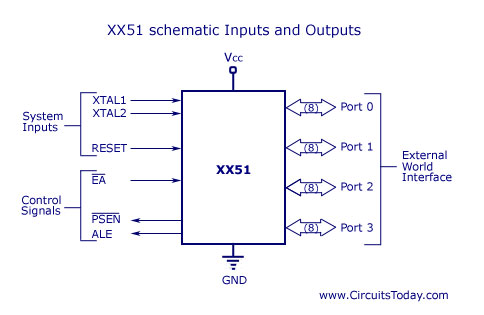
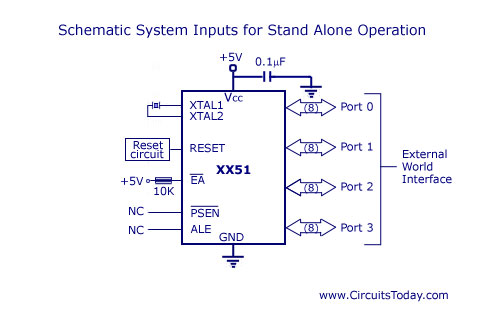
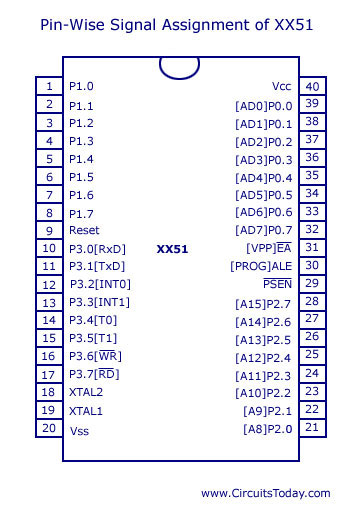
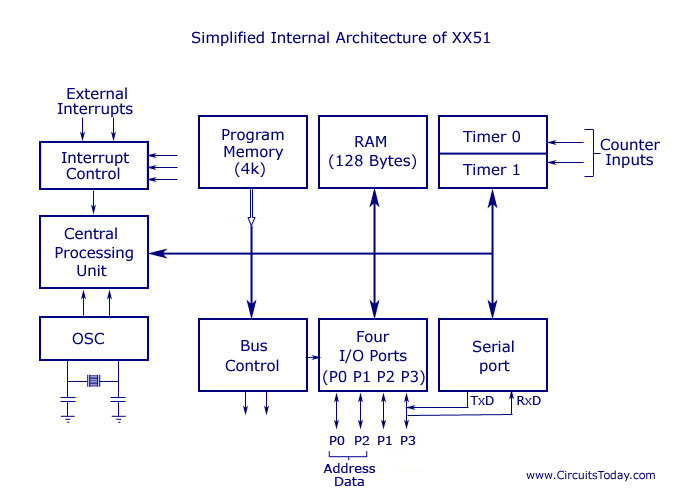
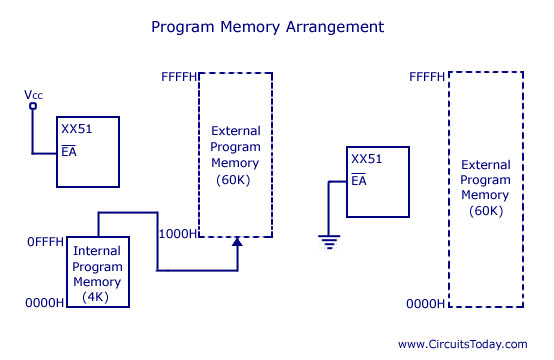
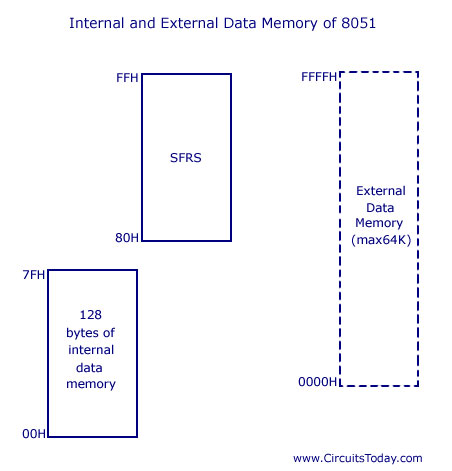
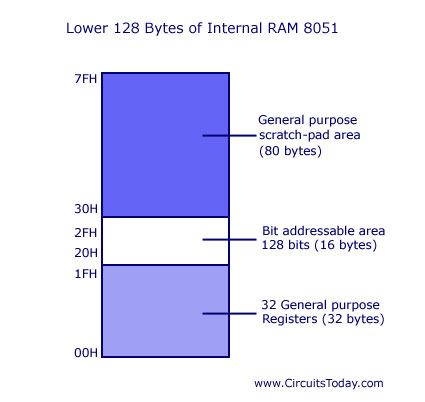
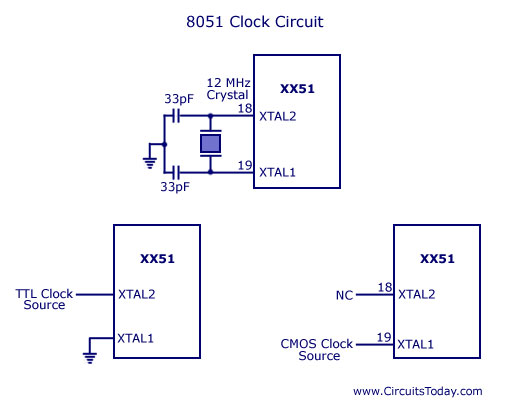
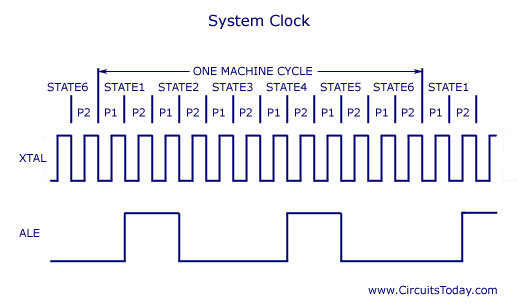
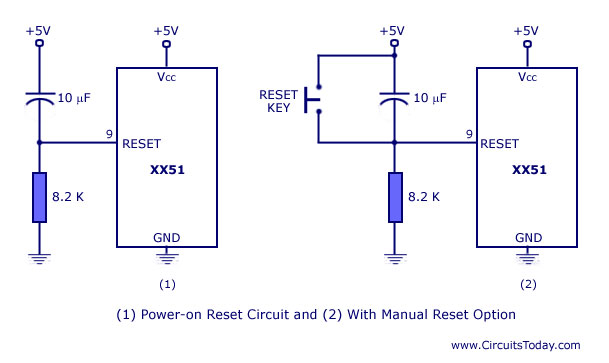
48 Comments
There is four port but port o and port 2 not understand please explain these two port , what purpose of this output or input. And where will be get right output.
its good. thank u
It is a very nice explaination for understanding the 8051.
Thanks. waiting for the explainations of other controller PIC and Arm as well as rasberry pie
Awesome article sir.Hoping for some more article of this kind.
very well written article
Hi guys,
i am student, and i am doing final year project. I wish to know what is the minimum voltage that you can give at the input port of the 8051, and the ideal voltage, so the 8051 can read it as a high(1) input.
Thanks
Joseph
@Joseph – it depends! You read the manufacturers datasheet to know about that. It varies with manufacturer. An idea is to condition the feeble voltage from sensor/input signal using Opamps and raise its level to 5V.
am third year student am doing project using 8051 micro controller basic stamp 2. please advise me how can i connect to the circut
why the bit addressable memory in 8051 micro contoller is restricted to 16 bytes
helpful,thanks
i am doing project using 8051.so please tell me about the how to use 8051.my project is energy maximum demand contoller
hello,
I am making a solar inverter using 8051, please give me some guidance and circuitry.
I also build a solar tracker .. so now i am moving one step to build an inverter.
Superab explanation .. it is really good one can easily understand the concept we need more like pentinum features can u provide?
It’s was nice explaination
Why the bus control used in 8051 microcontroller
Bus is a place where every block in the 8051 is interconnected. So when ever we used to send data from one block to another, we need to use the bus. but when more than one blocks are used to transfer the data then there exists problem, this problem can be eradicated by bus control logic.
bus control logic plays an key role in transfer of data.
It’s was nice answer
Why the bus control used in 8051 microcontroller
Nice one….Post in about various programming concepts of the MC..It will be great if you explain Embedded C programming
I need to add IC8051 to a pic c program.
I am using reg51.h file there.
in that I should set device name.
What is the name I should use?
nice explanation. it has vital informations to read an 8051 core and its architecture. thanks for building this article.
It ll be more helpful, still more concepts are to be explained like configuring timers ,counters, interrupts…
thanks again
timing diagrm ni h vo b daldo plzzz ar uski explaintation b…
why the capacitor is placed in between vcc and reset in 8051 microcontroller
wow its excellent
superb explanation in lucid language.keep going……
my question is that why capacitors are used in crystal ckt of 8051 & value are 33pf why???
Capacitors are used with oscillators because output of oscillator is clock pulse having some frequency along with noise (harmonic distortion) having very much heigher frequency, now by using these ceramic cpacitors the high frequency noise will be grounded and clock pulse having comparitively low frequency is supplied to MC that is almost free of distortion.
nice explanation
i want to know.why keep the name of 8052 microcontroller.and what is the logic behind it
Nicely explained,with easy language
i want to purchase microcontroller 8051,so please provide me address of manufacturer
You may buy AT89S51 – from Atmel
hello sir,
i want to know about 16 bit 80286 processor and 32 bit 80486 processor architecture….
plz help me
Hello Nikhil, Please keep waiting. We will definitely come up with articles on 16 bit and 32 bit architectures.
if there is internal pullups to port 1, 2, 3… then why we connect external 10 k pull ups to it? there is necessary??? and what happend if pull ups are ubsent to port 1, 2, 3?
Good Explanation Sir,
It Helped me a Lot !!!!
very helpful post for students..
sir,what is the difference between timer and counter
Counter: Counts and indicates the number of signals (events) input at any interval.
..
Timer: Counts the number of signals input at a constant interval to indicate the elapsed time.
In simple words counter counts the no of event is being exicuted while timer are basically used for time delay generation.
Easily understandable ……..
Very useful for students…
Hello Sameer,
Can you point me an example ?
Sir,
in most of the programs of 8051 microcontroller,I see “0*85,0*AF etc.” what is it’s mean?
u alwyas c such notaion in c language programming of uc
this means to ir 0AF AS A HEX NUMBER
good information for technical students.
your explanasion is easylyunderstandable for every student we wantmore information from you plese send me my email id dhupamsai16@gmail.com
pls sumbody tell me sumthng about how to solder the headphone jack…….
very nice one for students 😉
Superb post. Thanks for sharing. 🙂
want more like this.